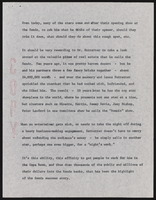Search the Special Collections and Archives Portal
Search Results
Showgirl and Stardust logo image unveiled on Western Pacific Airlines: video, approximately 1985 to 1995
Level of Description
Scope and Contents
Segment by unknown San Diego newstation on the expanding population, real estate, and economic upturn that Las Vegas is experiencing. Video opens with a Stardust Hotel and Casino craps game, while a voiceover describes Las Vegas as "Lost Vegas" and "Lost Wages" but that tourists and locals live together side-by-side. Reporter explains the population is rapidly growing, and many Californians and San Diegans are moving to the city, as it rebrands from "Sin City" to a reasonable, welcoming place to live. The reporter explains that many casinos were "in the red" and how it was in a economic downturn. However, many new casinos are being expanded or new ones built now that the economy is looking up. Features many shots of the Stardust Hotel interior and exterior. Original media VHS, color, aspect ratio 4 x 3, frame size 720 x 486.
Archival Collection
Collection Name: Stardust Resort and Casino Records
Box/Folder: Digital File 00, Box 031
Archival Component
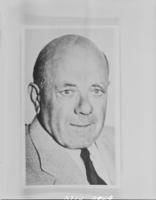
Photograph of P. A. "Pop" Simon, circa 1940s-1960s
Date
Archival Collection
Description
Image
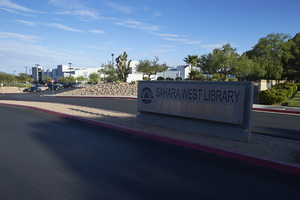
Sahara West Library, Las Vegas, Nevada: digital photograph
Date
Archival Collection
Description
Image
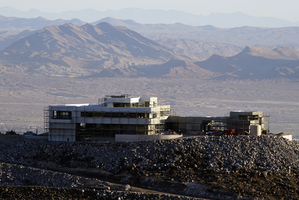
Development of upscale homes in mountains, Henderson, Nevada: digital photograph
Date
Archival Collection
Description
Image
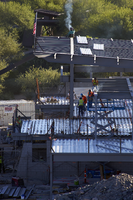
Ascaya Clubhouse under construction, Henderson, Nevada: digital photograph
Date
Archival Collection
Description
Image
Peter James Guzman oral history interview
Identifier
Abstract
Oral history interview with Peter James Guzman conducted by Claytee D. White on September 10, 2018 for the Latinx Voices of Southern Nevada Oral History Project. In this interview, Guzman discusses his family's history and shares his father’s emigration story from Cuba to the United States. He recalls growing up in Las Vegas, Nevada, attending Chaparral High School, living on 28th Street and Bonanza, and his career in real estate. Lastly, Guzman talks about his role as President of the Latin Chamber of Commerce, Vice Chairman of Hope for Prisoners, and Vice Chairman of Workforce Connection.
Archival Collection
Charmaine Lai oral history interview
Identifier
Abstract
Oral history interview with Charmaine Lai conducted by Cecilia Winchell and Stefani Evans on November 24, 2021 for Reflections: The Las Vegas Asian American and Pacific Islander Oral History Project.
Charmaine recounts her childhood growing up Hakka Chinese in South Africa. She discusses both the positives of growing up in South Africa, including the beautiful scenery and her family's cooking and traditions, and the negatives including the discrimination she faced in school and in her work. Charmaine also talks about her immigration to the United States, raising her three children, and her work as a real estate agent.
Archival Collection

Transcript of interview with Morris "Moe" Dalitz by Brenda Baxter, November 4, 1977-March 30, 1978
Date
Description
Interview with Morris "Moe" Dalitz by Brenda Baxter, on several dates in late 1977 to early 1978. In this interview, Dalitz talks about his business and career endeavors before coming to Las Vegas, which included a laundry service and military service. Dalitz partnered with Wilbur Clark and became a successful hotel and casino owner in Las Vegas, as well as a real estate developer with properties including the Boulevard Mall and Sunrise Hospital.
Moe Dalitz was born in Boston in 1899, and soon after his family moved to Detroit, Michigan and where his father started a linen supply company. In 1930, during Prohibition, Moe moved to Cleveland, Ohio and he became involved with the then-illegal liquor business. At the age of 41, Dalitz enlisted in the Army and was stationed at Governors Island. Moe was put in charge of laundries and dry cleaning because of his experience in the laundry business. He played an important role in creating mobile laundry units that were used in the front lines in North Africa. His ingenuity won him a non-combatant award for his "unusual interest, ingenuity and talents" applied during his service. At the end of war, Moe returned to Cleveland, where his partners were successfully carrying on their business. It was then that they decided to go into the casino-nightclub business, opening nightclubs in Ohio and Kentucky. A couple years later, Moe and his partners met Wilbur Clark and agreed to finance his inactive project in Las Vegas. Thus, in 1950, the Desert Inn Hotel and Casino opened, and Moe Dalitz ushered in a new era for the city. Moe and partners continued to elevate the sophistication of the Strip when they acquired the operating lease to, and later part ownership of, the Stardust Hotel and Casino. Moe was instrumental in bringing the French Lido de Paris show to the Stardust, which was considered the most spectacular nightclub show produced in Las Vegas at its time. In addition to his gaming industry ventures, Moe engaged in significant real estate development, along with partners Allard Roen, Merv Adelson and Irwin Molasky. Their projects included Sunrise Hospital, The Boulevard Mall and Las Vegas Country Club as well as La Costa Resort and Spa in California. At the time of the interview, Moe was involved with the construction of a downtown hotel and casino. Moe Dalitz was the recipient of the Humanitarian Award from the American Cancer Research Center, and supported the Variety Club and the Home of the Good Shepard, amongst other charities.
Text
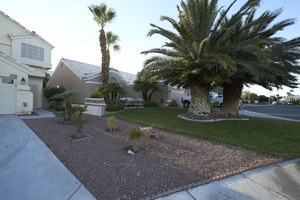
Single family residences with desert landscaping and grass near West Sahara Avenue, Las Vegas, Nevada: digital photograph
Date
Archival Collection
Description
Image

